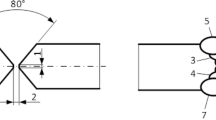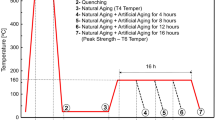Abstract
Multiphase steels are new Advanced High Strength Steels (AHSS), which have been developed for the automobile industry for the purpose of reducing of car body weight. These steels offer an excellent combination of high strength and large elongation due to the coexistence of harder and softer phases in their microstructure. The advantageous properties of multiphase steels can be utilised by regulating the type, amount, formation and spatial distribution of the different constituent phases. To describe the influences of the heterogeneous microstructure on the mechanical properties and the complex fracture mechanisms, an approach is presented using Representative Volume Elements (RVEs) on a micro level. Three dimensional RVE simulations were conducted under considerations of metallographic analysis for a Dual Phase (DP) steel and a Transformation-Induced Plasticity (TRIP) steel. The Gurson–Tvergaard–Needleman (GTN) damage model was applied to investigate the local crack initiation in steel sheets during various forming processes. In conclusion, a failure prediction based on microstructure is proposed for the material characterisation in sheet metal forming of multiphase steels.
Similar content being viewed by others
References
Al-Abbasi FM, Nemes JA (2003) Micromechanical modeling of dual phase steels. Int J Mech Sci 45: 1449–1465. doi:10.1016/j.ijmecsci.2003.10.007
Bergström Y (1969) A dislocation model for the stress–strain behaviour of polycrystalline α-Fe with special emphasis on the variation of the densities of mobile dislocations. Mater Sci Eng 5: 193–200. doi:10.1016/0025-5416(70)90081-9
Bernauer G, Brocks W (2002) Micro-mechanical modelling of ductile damage and tearing—results of a European numerical round robin. Fatigue Fract Eng Mater Struct 25: 363–384. doi:10.1046/j.1460-2695.2002.00468.x
Bernauer G, Brocks W, Muehlich U, Steglich D, Werwer M (1999) Remark for application of the Gurson–Tvergaard–Needleman model. Technical Note GKSS/WMG/99/10, GKSS, 1999
Bouquerel J, Verbeken K, De Cooman BC (2006) Microstructure-based model for the static mechanical behaviour of multiphase steels. Acta Mater 54: 1443–1456. doi:10.1016/j.actamat.2005.10.059
Cornec A, Scheider I, Schwalbe KH (2003) On the practical application of the cohesive model. Eng Fract Mech 70:1963–1987. doi:10.1016/S0013-7944(03)00134-6
Dziallach S, Bleck W, Blumbach M, Hallfeldt T (2007) Sheet metal testing and flow curve determination under multiaxial conditions. Adv Eng Mater 9:987–994. doi:10.1002/adem.200700129
Final Report ULSAB (1998) UltraLight steel auto body. American Iron and Steel Institute, Washington, DC
Gammage J, Wilkinson D, Brechet Y, Embury D (2004) A model for damage coalescence in heterogeneous multi-phase materials. Acta Mater 52: 5255–5263. doi:10.1016/j.actamat.2004.07.009
Garrison WM Jr, Moody NR (1987) Ductile fracture. J Phys Chem Solids 48: 1035–1074. doi:10.1016/0022-3697(87)90118-1
Godereaux S, Vivet S, Beaudoin JF (2002) Application of TRIP steels in the automotive industry. In: De Cooman BC (ed) Proceedings of the international conference on TRIP-aided high strength ferrous alloys, Gent, 2002
Horvath CD, Fekete JR (2004) Opportunities and challenges for increased usage of advanced high strength steels in automotive applications. In: Speer J (ed) Proceedings of the international conference on advanced high strength sheet steels for automotive applications, Colorado, 2004
Kaluza WM, Lake M, Pesek L, Bleck W (2000) Modelling of mechanical properties and local deformation of multi phase high strength steels. In: Abstracts of the international congress on advanced materials, their processes and applications (Materials Week 2000), Munich, 25–28 September 2000
Kikuma T, Nakazima K (1971) Effects of deforming conditions and mechanical properties on the stretch forming limits of steel sheets. In: Proceeding of ICSTIS, vol 11, pp 827–831
Lemaitre J, Desmorat R (2005) Engineering damages mechanics, ductile, creep, fatigue and brittle failures. Springer- Verlag, Berlin
McCutcheon DB, Trumper TW, Embury JD (1976) Controlled rolling of acicular ferrite steel plate. Rev Metall 73: 143–174
Muehlich U, Siegmund T, Brocks W (2000) A user-material subroutine of the modified Gurson–Tvergaard–Needleman model of porous metal plasticity for rate and temperature dependent hardening. Technical Note GKSS/WMG/98/1, GKSS, 2000
Nakazima K, Kikuma T, Hasuka T (1968) Study on the formability of steel sheets. Yawata Tech Rep 284: 140–141
Needleman A, Tvergaard V (1987) An analysis of ductile rupture modes at a crack tip. J Mech Phys Solids 35: 151–183. doi:10.1016/0022-5096(87)90034-2
Papaefthymiou S, Bleck W, Prahl U, Carmen A, Sietsma J, Van der Zwaag S (2003) Micromechanical damage simulations of TRIP steels. Mater Sci Forum 426–432:1355–1360
Papaefthymiou S, Prahl U, Bleck W, Van der Zwaag S, Sietsma J (2006) Experimental observations on the correlation between microstructure and fracture of multiphase steels. Int J Mater Res (formerly Z Metallkd) 97:1723–1731
Pickering FB (1992) Constitution and properties of steels. In: Cahn RW, Haasen P, Kramer EJ (eds) Materials science and technology (a comprehensive treatment), vol 7. VCH, New York
Prahl U (2003) Schädigung und Versagen mikrolegierter Feinkornstähle in Experiment und Simulation. Dissertation, RWTH Aachen University
Prahl U, Uthaisangsuk V, Papaefthymiou S, Bleck W, Sietsma J, Vander Zwaag S (2007) Micromechanics-based modelling of properties and failure of multiphase steels. Comput Mater Sci 39: 17–22. doi:10.1016/j.commatsci.2006.01.023
Reisner G, Werner EA, Fischer FD (1998) Micromechanical modeling of martensitic transformation in random microstructures. Int J Solids Struct 35: 2457–2473. doi:10.1016/S0020-7683(97)00149-2
Rodriguez RM, Gutierrez I (2003) Unified formulation to predict the tensile curves of steels with different microstructures. Mater Sci Forum 426–432: 4525–4530
Rodriguez RM, Gutierrez I (2004) Mechanical behaviour of steels with mixed microstructures. In: Lamberigts M (ed) Proceeding of the 2nd international conference on thermomechanical processing of steels (TMP 2004), Liege, 2004
Ruggieri C, Panontin TL, Dodds RH (1996) Numerical modeling of ductile crack growth in 3-D using computational cell elements. Int J Fract 82: 67–95. doi:10.1007/BF00017864
Shan ZH, Gokhale AM (2001) Micromechanics of complex three-dimensional microstructures. Acta Mater 49: 2001–2015. doi:10.1016/S1359-6454(01)00093-3
Tasan CC, Hoefnagels JMP, Peelings RHJ, Geers MGD, Ten Horn CHLJ, Vegter H (2007) Ductile damage evolution and strain path dependency. In: Cueto E, Chinesta F (eds) AIP conference proceedings, Zaragoza, Spain, 2007, pp 187–192
Thomser C, Prahl U, Vegter H, Bleck W (2007) Modelling the mechanical properties of multiphase steels. In: Szeliga D (ed) Proceeding of the 14th conference computer methods in material science, Zakopane, 2007
Tvergaard V (1981) Influence of voids on shear band instabilities under plane strain conditions. Int J Fract 17: 389–407. doi:10.1007/BF00036191
Tvergaard V, Needleman A (1984) Analysis of the cup-cone fracture in a round tensile bar. Acta Mater 32: 157–169. doi:10.1016/0001-6160(84)90213-X
Uthaisangsuk V, Muenstermann S, Prahl U, Bleck W (2008) Experimental and numerical failure criterion for formability prediction in sheet metal forming. Comput Mater Sci 43: 43–50. doi:10.1016/j.commatsci.2007.07.036
Zhang Y, Chen ZT (2007) On the effect of stress triaxiality on void coalescence. Int J Fract 143: 105–112. doi:10.1007/s10704-006-9045-2
Author information
Authors and Affiliations
Corresponding author
Rights and permissions
About this article
Cite this article
Uthaisangsuk, V., Prahl, U. & Bleck, W. Characterisation of formability behaviour of multiphase steels by micromechanical modelling. Int J Fract 157, 55–69 (2009). https://doi.org/10.1007/s10704-009-9329-4
Received:
Accepted:
Published:
Issue Date:
DOI: https://doi.org/10.1007/s10704-009-9329-4




